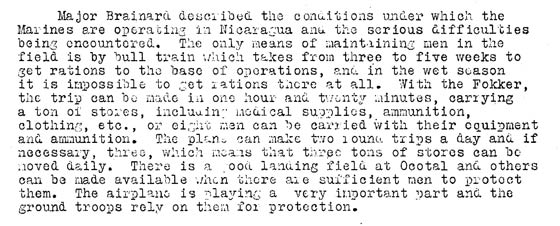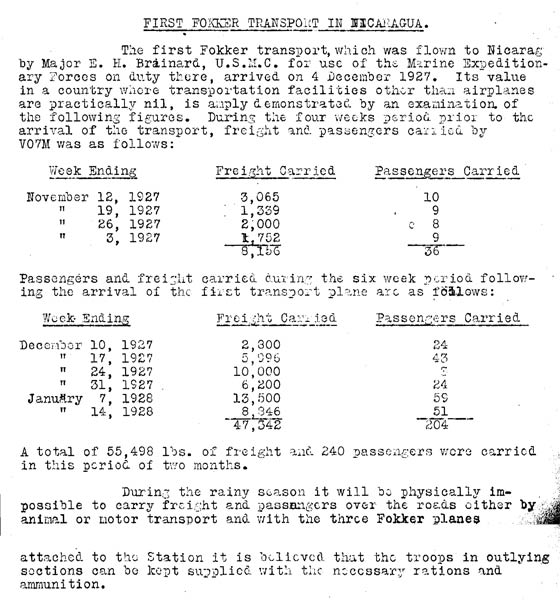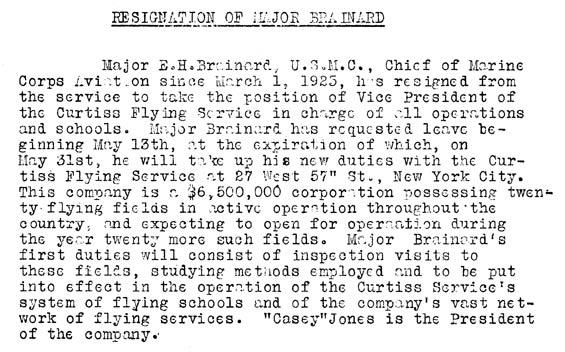|
Edwin Brainard was born in Meriden, CT September 6, 1878. He was one of the older pilots to sign the Register. He attended Meridan public schools and graduated from the New York Nautical School. The School is now the State University of New York Maritime College, and it is the oldest institution of its kind in the United States. He earned and held a Chief Mate's license in the Merchant Marine.
On January 9, 1909, he was commissioned in the Marine Corps and served with the Fifth Artillery Brigade. From his NASM record it is not clear what his promotion regime was like over the next decade. But, during WWI, he was attached to the 20th Regiment as Observer at St. Die, Vesges; the 16th Regiment, 4th Field Artillery on the Vesle, Aisne-Marne Offensive, and participated in the St. Mihiel, Muese-Argoonne, Champagne and Argonne First Offensives. He commanded the 1st Battalion, 15th Regiment of the Field Artillery. On January 21, 1919, he was detached from duty with the Field Artillery and assigned to the 6th Regiment, Marines, commanding the 2nd Battalion.
Unsourced Minnesota News Article, December 3, 1927 (Source: NASM)
 |
For his WWI service, he was cited by the French Government for gallantry in action and was awarded the Croix de Guerre with Gold Star. For his gallantry in action on November 3, 1918, he was awarded the Army Citation and Silver Star. In 1920 he was awarded the Navy Cross for exceptionally meritorious and distinguished service.
In December, 1920, he earned his wings at Pensacola, FL. He immediately began making notable flights. During the 1920s, he made a round-trip transcontinental flight in a Curtiss Hawk. He made the longest flight to-date in an amphibious aircraft: Washington, DC to Haiti for an inspection of the Marine detachment there.
In the midst of all this, then Major Edwin Brainard landed once at Tucson, on Monday, May 31, 1926 at 10:45AM. He carried a single passenger identified as Master Tech. Sgt. R.S. Fry. Based at Washington, DC, they were westbound from El Paso, TX to San Diego, CA in a Boeing O-2B1, A-6908. No reason was given in the Register for their flight. And there is no indication that he used this airplane for any of his record flights.
In January, 1927, he flew from Washington to Pensacola in 6 hours 45 minutes. A day later he made the return trip in 5 hours 25 minutes. That September, he led a formation of Curtiss Hawks from Buffalo to Washington in the record time of 2 hours 5 minutes.
Site visitor Russ Plehinger puts a finer point on this 1927 flight. It was a round-trip flight, with the return made a few days later. He tabulates the details as follows.
January 17, 1927.
Anacostia, D.C. to Pensacola, Florida.
850 miles.
9h 15m elapsed time.
6h 45m flying time.
125.93 mph.
Maj. Edwin H. Brainard USMC.
Curtiss F6C-4 Hawk, A-7395.
Takeoff at 8:20AM, landing at 5:35PM.
DETAILS AS FOLLOWS:
Anacostia to Augusta, Georgia----4h 10m
Augusta to Pensacola, Florida----2h 35m
----------
January 21-22, 1927.
Pensacola, Florida to Anacostia, D.C.
850 miles.
5h 25m flying time.
157.7 mph.
Maj. Edwin H. Brainard USMC.
Curtiss F6C-4 Hawk, A-7395.
Route----Pensacola-Americus, GA-Anacostia. |
On September 18, 1927 he entered and won a free-for-all seaplane race at New Haven, CT. The following article from the Bureau of Aeronautics Newsletter of October 5th reports the results.
Bureau of Aeronautics Newsletter, October 5, 1927 (Source: Webmaster)
 |
On December 3rd that year, he flew a Fokker trimotor with two other personnel from Miami to Nicaragua. The beginning of the flight was described in the unsourced news article, above right. They did make it to Central America, however they had to make a precautionary landing at Tela, Honduras because of low weather and low fuel due to headwinds. New headlines for a couple of days following described the shortfall and the completion of the flight on December 4th. This flight was the first across the Caribbean.
When they made it to Managua, Brainard was quoted in a December 5th newspaper, "I had hoped to arrive here yesterday [that would have been the 3rd], but heavy winds held me back. Leaving Tela this morning [the 4th], the weather was very bad and continued so until we were near Teguciagalpa [sic]. We then came into fine weather and headed for Managua. Our average speed from Tela was about 90 miles [per hour] and we took about three hours to make the trip [of about 250 miles]."
Brainard made a statement in the January 11, 1928 Bureau of Aeronautics Newsletter, below. He describes the utility of the Fokker.
Bureau of Aeronautics Newsletter, January 11, 1928 (Source: Webmaster)
 |
Further to the Fokker's utility, the following from the February 21, 1928 Bureau of Aeronautics Newsletter tabulates the numbers.
Bureau of Aeronautics Newsletter, February 21, 1928 (Source: Webmaster)
 |
Brainard terminated his military career when he resigned from the Marine Corps and took a position in industry. The BuAeroNews of May 15, 1929 cites his resignation, below. Note mention in the article of Register pilot Casey Jones.
Bureau of Aeronatics Newsletter, May 15, 1929 (Source: Webmaster)
 |
---o0o---
Dossier 2.2.34
THIS PAGE UPLOADED: 05/05/10 REVISED: 01/17/11, 02/01/11, 04/01/11
|






